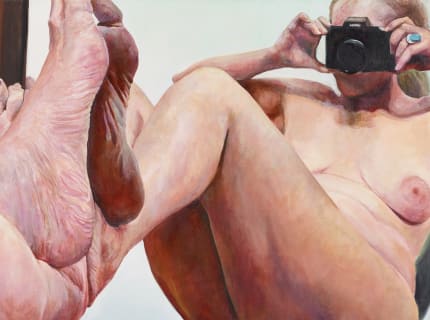AMID a stream of feature articles highlighting young artists who have hit stardom quickly, it is nice to be reminded of those who have been producing serious, thoughtful work for several decades. There are substance and quality, as well as a few surprises, in the cluster of five solo exhibitions currently at the Benton Gallery in Southampton.
The energies in paintings by Joan Semmel and Ce Roser are combined with a good measure of painterly logic. In the Roser nature-based abstractions, for example, many short diagonal strokes, all rhythmically parallel, lend a pleasing mottled glow.
These are paintings that evoke Kandinsky's spiritual attitude toward the universe, and his Esperanto language of abstract shapes stimulated by natural phenomena. Arcs are a principal motif, and they readily translate into hills, mountains, clouds and fields. The best works, such as ''Fields of Light,'' are almost metaphysical.
These visions are interpreted in two ways. Some can be stark and provocative, with the barest of thin contour lines sweeping across a white surface, while others are more richly and densely colored and come closer to landscapes' busy mood. Some of the paintings tend to emphasize a gentle lyricism at the expense of power, but there are several small, sparkling watercolors that have considerable zest and imagination.
It is the Semmel paintings that are the most powerful here. Nude self-portraits or two-figure studies, they are a conscious attempt to create paintings that work as dynamic surface structures as well as descriptions of the figure in radically foreshortened space. This challenge is handled with dramatic results.
Most of the examples on view date from the late 70's. When they were shown in New York at that time, there was a rush to link them to the women's-consciousness movement. Other connections seem significant, too, particularly the overt commentary on photography, with its propensity for unusual angles and abruptly cut-off edges, and the association with the new gravity-free environment that seems appropriate to space-age perceptions.
Much can be said, too, for the visual strength that comes from using multiple brushwork techniques in the same work. One limb might have the smooth, unbroken illusion of solidity, while another might be a vigorous expression of loose, boldly colored paint gestures. This intended complexity is very effective in handsome drawings that include inset views showing different interpretations of the subject.
...
Read full article at nytimes.com.

